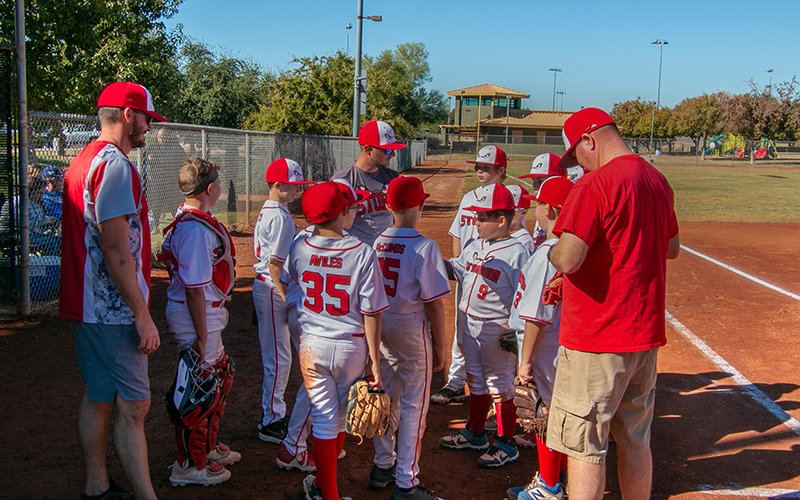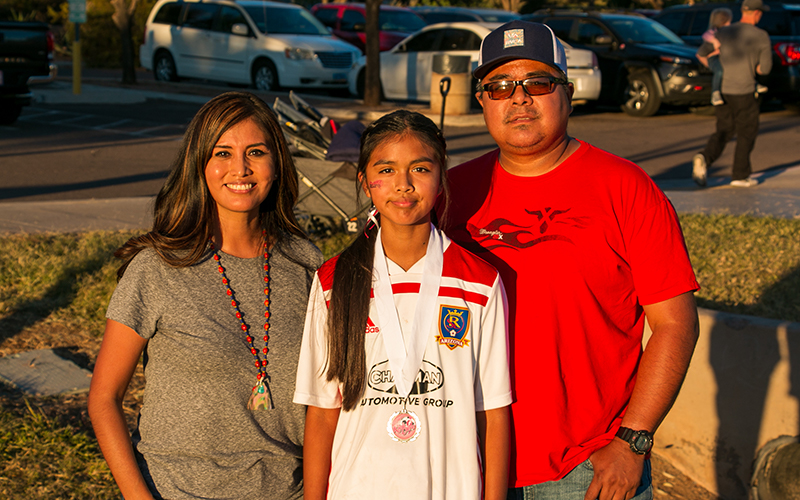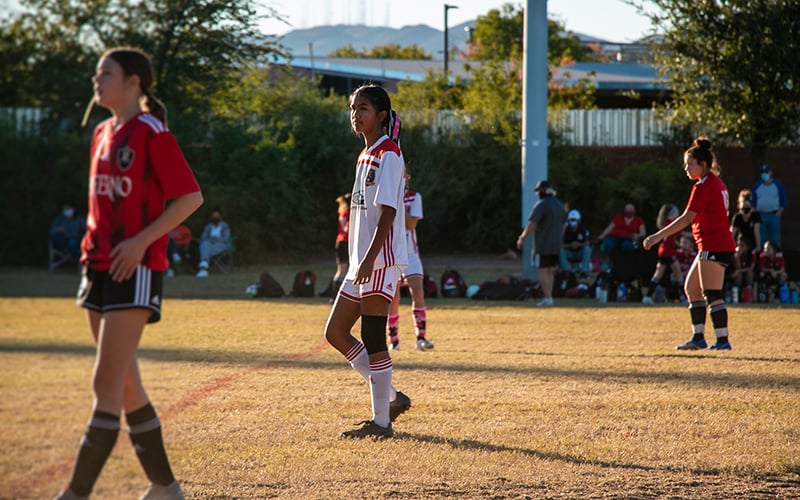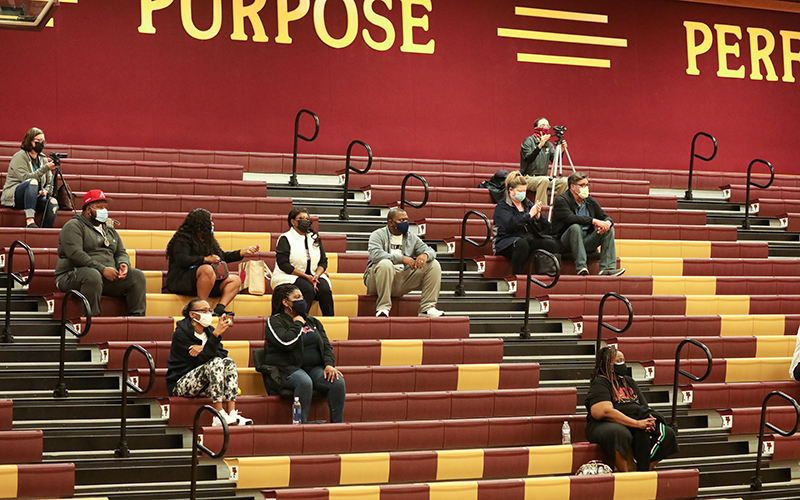PHOENIX – Krystle Mann, a stay-at-home mother to three sons, makes and sells cornbread and jam to pay for new baseball gear and help cover club fees – approximately $1,500 per year.
Her older son, Sam, 12, plays for the AZ Diamond Dawgs in Queen Creek, while her middle son, Tommy, 11, plays for both the Paladin Knights and AZ Storm in San Tan Valley. Both boys have played baseball for about seven years, making the transition from Little League to club baseball recently.
Club sports are run by private associations that, unlike school-sponsored sports programs, charge high fees to participants who are hoping to enhance their individual or team skill.
“I think this has been the best thing for the boys mentally, physically and emotionally,” Mann said.
Some families say club sports are worth the high costs for the confidence, friendships and athletic skills their children gain, but not all can afford the fees.
A 2013 study by the Open Access Journal of Sport Medicine reports that 75% of U.S. families with school-aged children have at least one playing an organized sport, or about 45 million kids.
But there is a clear economic divide between higher- and lower-income families in youth sports.
To cover the costs that come with club sports, many families turn to fundraising, donations and scholarships.
Mann said the rising cost of youth sports has been a huge factor when choosing where her sons play club baseball. With her husband, Tom, a bank employee, she researched each club’s monthly dues, charges for required hitting and fielding lessons plus tournament, travel and equipment costs.
“It’s getting very expensive. It only used to be $150 to play ball (in Little League). Now I always joke and say I have to take a second mortgage,” she said.

The AZ Diamond Dawgs in Queen Creek, led by coach Matthew McCombs, are one of many accomplished club programs in Arizona. (Photo by Christian Quezada/Special for Cronkite News)
According to Mann, the monthly dues are advertised, but all the hidden costs of traveling for tournaments every weekend aren’t. On average, the Manns pay $650 in club dues for their sons’ three teams combined, but they spend about $500 a weekend on tournament travel costs. The family has traveled all over Arizona, from Lake Havasu to Tucson to Flagstaff. Mann packs meals for the trips to save money for hotel rooms and gas.
Normally, a team competes in two tournaments a month, but with two boys playing, one year-round, Mann said her family is on the road every weekend. She and her husband often have to stay at different hotels because the tournaments are in different locations.
“Your son is already so excited about the team that you have to come up with these extra costs that you aren’t prepared for,” she said.
Mann isn’t alone in her sentiment. She considers her one-paycheck family as middle-income with a lot of mouths to feed, but others have it worse.
According to a national parent survey from the Aspen Institute’s Project Play initiative and Utah State University’s Families in Sport Lab, children aged 6-18 from low-income families are six times more likely to quit sports at the recreational, club and high school levels for financial reasons than children from higher-income families.
The same survey cites the average annual cost per child playing a youth sport to be $693, which hovers around the averages for baseball ($660) and soccer ($537). The average costs take into account registration, equipment, travel, lessons and camps. However, the cost that exceeds all others is travel, especially for the Manns. Travel is a major part of the estimated $17 billion youth sports industry.
Fundraising in other ways
For Tanayia White, the cost of traveling is much higher during her 12-year-old daughter’s soccer season. White drives two and a half hours to Tucson once per month, so that her daughter, Tashoney Kniffin, can practice soccer with a competitive team of her age and skill level.
Members of the San Carlos Apache Tribe, White and Tashoney have lived 30 miles from the reservation in Safford for the past five years. Tashoney plays for two soccer teams under the Real Salt Lake-AZ soccer club, one in Safford and the other in Tucson.
But traveling to the Phoenix metro area to compete is even more challenging. White is the only source of income for her family. She works as a lead Native American affairs specialist for an international corporation, while her husband, Ivan Kniffin, is a student studying geomatics at New Mexico State University. The drive from Safford to Phoenix takes three to four hours and the weekend trip costs can total $300-$600. With seven tournaments per season, the expenses add up.
White said her family wouldn’t be able to afford all the costs without fundraising. Her team in Safford has organized fundraisers to cover costs among all the players’ families, but White said she and Tashoney have done even more fundraising specifically for their family. They have the reservation community energized and contributing to the fundraisers, thanks to a local newspaper covering Tashoney’s progress as a player.
“As Native Americans … I think that we have a special responsibility to keep our unique cultural identity,” White said. “I think that soccer is the perfect forum for …Tashoney (to) be a wonderful representative of our tribe and our people.”
Tashoney wants to play through high school and college and eventually play professionally. White said she doesn’t want expenses to keep Tashoney from achieving her goals.

Tashoney Kniffin (center), with her parents Tanayia White and Ivan Kniffin, hopes to eventually play professionally. (Photo by Christian Quezada/Special for Cronkite News)
Other parents are similarly dedicated to making sure their kids and others can play, whether they can easily afford all the fees or not.
Sherri Morganfield, whose 12-year-old son, Devin, plays club baseball for the U12 Casa Grande Royals, said intensive team fundraisers are necessary to cover the most basic fees for many of the team’s 11 players. Working in healthcare sales, Morganfield said her family pays Devin’s fees in full, but the fundraising allows other families to participate. When new athletes join the club, they pay the $100 uniform fee and then $75 per month until the next hosted tournament. Then, the youth’s fees are covered by the fundraising.
“If we have to put in this extra time, energy and effort in order to make (club baseball) affordable for everybody, that’s what we’re going to do,” Morganfield said.
Since a USSSA Baseball tournament costs $500-$600, Morganfield said the team has to fundraise more than $4,000 to cover everything to avoid families paying more out of pocket than they can afford.
The origin of rising costs
Eric Legg, assistant professor in Arizona State University’s School of Community Resources and Development, researches youth sports and youth development. He traces the increase in youth club sport fees in the Phoenix area specifically to the 2008 recession when Phoenix Parks and Recreation cut most of its youth sport programs.
He said many government parks and recreation agencies used to fund a large percentage of recreational youth sports with tax dollars.
Since 2008, Legg said some private groups and nonprofit organizations have attempted to keep costs down, especially in soccer, football and baseball.
Danny Grimes, association director of sports and aquatics at Valley of the Sun YMCA, said the Y’s mission is to not turn away any family for financial reasons. The nonprofit’s scholarship fund subsidizes whatever a family may need financially.
With 17 locations across Arizona, Grimes said the YMCA serves communities of all incomes.
Grimes said the nonprofit is always in need of community partnerships to ensure the scholarships can continue.
Unlike the YMCA’s goal of teaching youth development, healthy living and social responsibility, Legg said some of the newer programs, particularly nonprofit soccer leagues, are more focused on building players’ individual athletic skills than building a community among players.
Mann said building athletic skills is important, but making a team into a family is far more important for 11- and 12-year-old boys who need friendships and confidence.
The competitive nature
Among clubs, there are large differences in costs and coaching expertise, just as there are differences in high school and college sports teams. As a result, Legg said there has been a clear increase in performance culture with more competitive travel leagues. Some coaches teach their players to focus on winning the game over anything else. Parents also want their children to succeed to the highest level, particularly as that can mean a ticket to a college athletic scholarship, which is dangled to parents as a club benefit.
“Obviously, the main goal is to get into the major leagues, but the other goal is to get a full-ride scholarship and notoriety,” said Tony Coletta, president of Old Scottsdale Youth Baseball League, a nonprofit organization.
Jon Solomon, editorial director of the Aspen Institute’s Sports & Society Program, said parents’ often unrealistic expectations of their children playing at the collegiate and professional level only widens the economic gap between families in youth sports. He said wealthier families can afford the more expensive training resources to get their children to a point where recruiters may notice them.

Sherri Morganfield, the mother of Devin Morganfield (left) said the Casa Grande Royals had to fundraise more than $4,000 to avoid families paying more out of pocket than they can afford. (Photo by Christian Quezada/Special for Cronkite News)
Putting the money parents spend on their children’s sports aside into a college fund is something they should consider instead, Solomon said, “as opposed to spending it (on) something that potentially may not happen.”
Solomon said youth athletes from low-income families have to be extraordinarily talented to receive scholarships to join competitive clubs or elite leagues. Families with children who don’t have the raw ability or can’t afford training to get to a competitive level are often left behind.
Legg said the system of giving a few scholarships from elite clubs to extraordinarily talented children from low-income families is a window dressing that perpetuates elite play.
Sometimes these scholarships exist only in populated, metro areas where there is money and competitive leagues, Legg said. Kids in rural areas might not have access to coaches who could take them to the next level.
Before Tashoney moved to Safford, 30 miles from the reservation where her mother’s family resides, she lived near Phoenix and played for Scottsdale Premier Soccer Club. White said her daughter’s coaches were from Brophy College Preparatory, a highly-regarded private high school in Phoenix with a competitive sports program. In Safford, however, Tashoney doesn’t have accessibility to the same level of training, even if they had all the funds to pay for resources. That is why she travels all the way to Tucson to practice with a more challenging team.
“(Tashoney) is coming to the point where she’s going to need a little bit more expertise,” White said. “I don’t know how to find that here in our small valley, aside from maybe hitting a lottery ticket.”
Equipment and private training
Like the most competitive training, having the best equipment unsurprisingly comes at a high cost.
Mann said the best baseball bats can go for up to $800, but she has taught her sons to do the best with what they have.
“I can make it with that equipment until it breaks,” 12-year-old Sam said.
Mann said sometimes her boys don’t understand why they can’t get new equipment right away. She has to remind them that they have to wait for their dad to get his bonus check at the end of the month. The boys also save up their allowances to buy their own gear.
While costs may be an issue for some families, Dr. Allison Perrin, a geriatrician, said her family is fortunate enough to hire a private soccer trainer for her 12-year-old son, Sam. He plays club soccer for Excel Soccer Academy in Central Phoenix and has one-on-one clinics two or three times a week. Perrin’s family spends about $2,000 a year for Sam’s private sessions, in addition to $1,000 for travel, $500 for equipment, $1,150 for club fees, $450 for tournament fees and $600 for donations for families who can’t afford club expenses.
“I think it’s an important life experience (for Sam to be around) people from different backgrounds (and) socio-economic statuses,” she said. “I think it’s part of well-rounded education.”
Keeping the costs down
Herber Valenzuela, former Arizona Soccer Association director of community relations, said the coach shouldn’t be the only person involved in shaping a young athlete, especially a soccer player. Teammates, parents and other community members are just as important for teaching teamwork, character-building and accountability.
However, he said building well-rounded athletes starts with lowering the costs of club soccer to help more kids get involved for the long-term. He said cheaper fees can be achieved in two ways if a soccer club is a registered nonprofit and accesses grants and corporate sponsorships.
McCombs said one of the primary ways he keeps the $105 AZ Storm monthly dues down for families is through four levels of sponsorships, from $250 to $1,000. Sponsors have their names on banners hung at every game. He also refers players and their families to these businesses whenever possible.
Legg said that bringing awareness to the economic disparities is the first step to fixing them, and several organizations are already doing that work. He said The Aspen Institute has “adopted” multiple communities and helped revamp their youth sport programs. To keep acknowledging and working toward finding a solution at not only the local level but also the national level, Legg said these organizations will continue to need funding.
Mann said parents also have power to close the economic gap so more kids can play. Facebook groups are a useful tool for sharing information about league finances and finding used equipment at a low cost or for free. She said the baseball community is so tight that they’re always willing to help each other out.
Looking forward, Mann said Sam’s team is headed to Cooperstown, New York, in June for a highly anticipated international tournament. The costs are yet another financial burden, but Mann and her husband will figure out how to get him there.
“We will do whatever we have to do,” she said. “If I have to sell a million jars of jam to get him to Cooperstown, I’m going to do it.”

